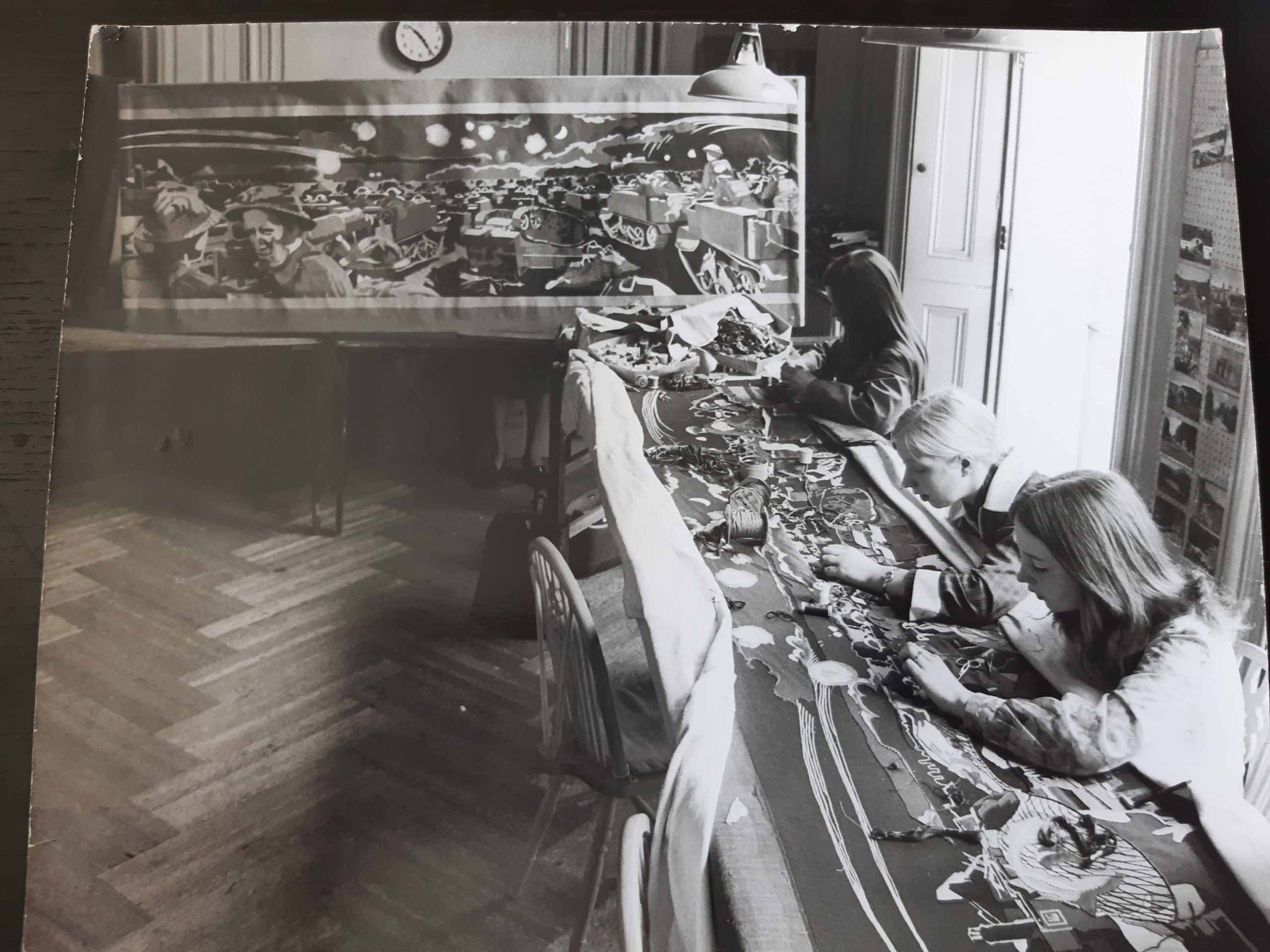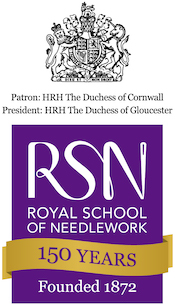Latest news
Keep up to date with all the latest news from the Royal School of Needlework
Behind the Scenes of Overlord Embroidery
1st September, 2020
Story from the Archives
In the late 1960s, the RSN was approached by Lord Dulverton who wanted to commemorate the D-Day events of 6 June 1944. He wanted to tell the whole story of the build-up and events of the day. This was to be a large project, so it was decided that the techniques should be similar to those used on the Hastings panels, ie Appliqué but with a number of differences.
For a start, where the Hastings embroidery had simple details and an almost cartoon style for events that happened hundreds of years ago, this was to be more detailed and recognising an event which had happened only 25 or so years earlier. There was also a need for more authenticity, so the RSN sought out the right materials for uniforms. The uniforms and all representations of the boats, aircraft and landscape would be in Appliqué, while the faces of the people would be embroidered using Silk Shading to give detail and credibility.
The panels were designed by Sandra Lawrence, then recently out of art school, and it was probably a mixed blessing. It was a fantastic project for her to work on, but every panel had to be approved by Lord Dulverton and his committee, with details being subject to the Ministry of War, as it was still entitled then.
 The RSN team was Project Managed by Miss Margaret Bartlett who kept a notebook of the project. She recorded technical information and notes on specific aspects, however she was not averse to recording comments on some of the people she had to deal with!
The RSN team was Project Managed by Miss Margaret Bartlett who kept a notebook of the project. She recorded technical information and notes on specific aspects, however she was not averse to recording comments on some of the people she had to deal with!
Quotes show the frequent inspections and approvals:
• The Imperial War Museum and General Brown inspected panels 7/10/69
• Lord Dulverton inspected two completed panels and one on frame 15./10/69
• 6.8.71 Miss Lawrence phoned Mr Lloyd (Principal of the RSN) and said Dwg no 27 just to be passed by Col Neave-Hill. Appointment to see Col Monday 9.8.71
Scrutiny of the panel went down to hairstyles and shadows.
• Comments after one visit by Lord Dulverton included: “Panel 33 Green shadow in trees to be darker, soldier hair and helmet to be neatened”.
• A few days later after a further inspection: “Shadow to be extended on road. End of gun to be altered”
Details were paramount. For example, it was important to show the leading military figures with the ribbons they had earned by that date, not the ones awarded later. In our archive, we still have an envelope entitled ‘Monty’s ribbons’. We did not use the ribbons themselves. In keeping with the piece, they were depicted in stitch. In the notebook we see it was not only Monty’s ribbons that were a problem.
• “Miss Lawrence has not been able to obtain the sequence of medal ribbons for HM The King so we cannot complete panel”
And cartoons (the drawings from which the stitchers worked) were going on private display before the official launch.
• “Mrs B phoned for General Brown to say they would like to hang 5 or 6 cartoons to show some Americans at a lunch party. No 8,9,10,15,18,28 collected by Messenger”
All these inspections and tweaks took time, all laid at the RSN, and Miss Bartlett’s frustration is clear when she writes:
• “It has been suggested, so Sandra tells us, that panels that are complete may have alterations. Both Mr Lloyd and myself said that we are against this idea. We will wait and see if anything is mentioned.”
Initially there were to be 30 panels, then this was increased to 33 but it was commented that there was nothing to record the devastation to the French countryside, so a final 34th panel was added.
In 1972 Michael Aspel came from the BBC to record an interview about them and Miss Bartlett was interviewed for the Today programme.
During the five years of work on the panels, the RSN workroom was joined by a young woman who had experience in stitch. She came on a month’s trial. Her name was Wendy Hogg and she stayed with us for more than forty years until 2011 when she died of cancer. Wendy specialised in Canvaswork and finishing techniques: stretching and mounting. She also taught these skills to many classes of RSN apprentices. When she died, she left the RSN a legacy and this is used for an annual prize for mounting. Wendy worked on many of the D-Day panels and did almost all the work on the final panel. Back in 2009, on the 65th anniversary, Her Majesty The Queen visited the D-Day museum and the RSN was invited to attend with Wendy and Elizabeth Elvin who had also done some work on the panels. Our Chief Executive, Dr Susan Kay-Williams, also attended and was honoured to have Wendy talk her through some of the challenges of the 34th panel.
When the project was first completed, it had been anticipated that it would be displayed at the Imperial War Museum, and they had visited frequently, but that was not to be. Initially, it was displayed at the Whitbread Brewery gallery in the City.
The most famous panel is number 28 which features the key players in the D-Day planning: King George VI, General Dwight D. Eisenhower, General Sir Bernard Montgomery (Monty), Sir Winston Churchill and Field Marshall Sir Alan Brooke. After all the stress on authenticity it is, however, the one false image as these people were never all in France at the same time.
The Queen Mother, Patron of the RSN, visited the embroidery when it was at the Whitbread and asked for more light on the face of the King. However, this was only a temporary home and it was far from certain where it would go for the long term until a special room was built for it at the D-Day Museum (now D-Day Story) in Portsmouth. It was opened in 1984 by The Queen Mother. The display was re-presented a couple of years ago and now features more of Sandra Lawrence’s research, the design process and the making of the piece by the RSN, including stories from those who worked on it.

